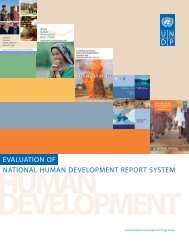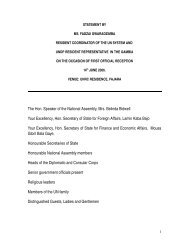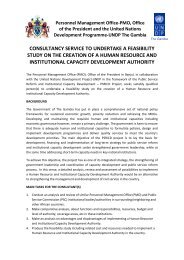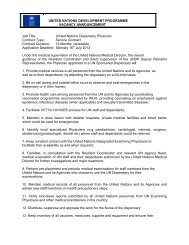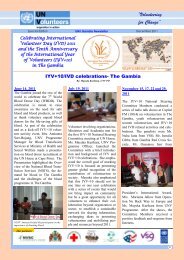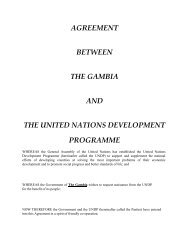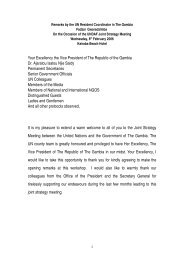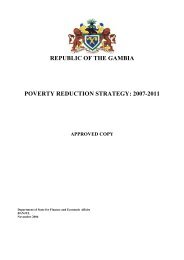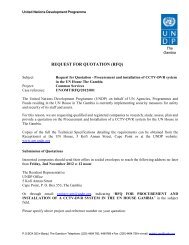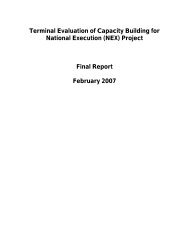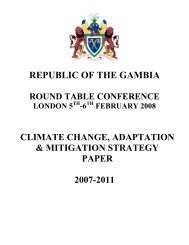Introduction - UNDP The Gambia
Introduction - UNDP The Gambia
Introduction - UNDP The Gambia
Create successful ePaper yourself
Turn your PDF publications into a flip-book with our unique Google optimized e-Paper software.
________________________________________________________________________________________________________________________<br />
Table 4: PRSP and MDG status and comparison<br />
MDG Targets PRSP Targets MDG Indicators Targets Actual<br />
Status<br />
2005 2015<br />
MDG 1 Eradicate extreme poverty A reduction by 66% MDG 1: 38 27 59% in 1998, and Severely<br />
and hunger. Halve, between 1990 of the number of proportion of results from 2003 off track<br />
and 2015, the proportion of people women living in population. Below household survey<br />
whose income is less than one dollar poverty by 2015. No the poverty line will provide more<br />
a day.<br />
specific target for (US$ 1 per day).<br />
recent data.<br />
population at large.<br />
MDG 1 Eradicate extreme poverty A reduction by 50% MDG 1: proportion<br />
and hunger. Halve, between 1990 of the number of of population<br />
and 2015, the proportion of people malnourished people below minimum<br />
who suffer from hunger.<br />
by 2015.<br />
dietary energy<br />
consumption.<br />
MDG 2 Achieve universal primary Universal primary<br />
education. Ensure that, by 2015, education by 2015,<br />
children everywhere, boys and girls with 80% completion<br />
alike, will be able to complete full in primary education<br />
course of primary schooling. by 2005.<br />
n/a 7.5 15% in 1990, 21%<br />
in 2000.<br />
Off track<br />
MDG 2: net 78 100 60% in 2000. Slightly off<br />
enrolment ratio in<br />
track<br />
primary education.<br />
MDG 3 Promote gender equality Attaining gender MDG 3: ratio of 100 100 96% in 2002 On track<br />
and empower women. Eliminate equity in primary girls to boys in<br />
gender disparity in primary and and secondary primary education.<br />
secondary education, preferably by enrolments by 2005. MDG 3: ratio of 100 100 79% in 2002 Off track<br />
2005, and at all levels of education<br />
girls to boys in<br />
not later than 2015.<br />
secondary.<br />
Education<br />
MDG 4 Reduce child mortality.<br />
Reduce by two-thirds, between 1990<br />
and 2015, the under-five mortality<br />
rate.<br />
MDG 5 Improve maternal<br />
health. Reduce by three quarters,<br />
between 1990 and 2015, the maternal<br />
mortality ratio.<br />
MDG 6 Combat HIV/AIDS,<br />
malaria and other diseases. Have<br />
halted by 2015 and begun to reverse<br />
the spread of HIV/AIDS.<br />
MDG 6 Combat HIV/AIDS,<br />
malaria and other diseases. Have<br />
halted by 2015 and begun to reverse<br />
the spread of HIV/AIDS.<br />
A reduction of the<br />
1990 infant and child<br />
mortality rates by<br />
33% by the year<br />
2015.<br />
A 50% reduction of<br />
the maternal<br />
mortality rate of<br />
1990 and a further<br />
50% by 2015.<br />
No comparable<br />
PSRP target.<br />
No comparable<br />
PSRP target.<br />
MDG 4: under five 82 45 135 deaths per Severely<br />
child mortality (per thousand live births off track<br />
1,000 live births).<br />
MDG 5: maternal 577 262 730 deaths per 100, On track<br />
mortality ratio (per 000 live births.<br />
100, 000 live<br />
births).<br />
MDG 6: spread of<br />
HIV/AIDS.<br />
MDG 6: spread of<br />
malaria and other<br />
major diseases.<br />
MDG 7 Ensure environmental No comparable MDG 7: loss of<br />
sustainability. Integrate the PSRP target. environmental<br />
principles of sustainable<br />
resources<br />
development into country policies<br />
and programmes and reverse the<br />
MDG 7: access to<br />
losses of environmental resources.<br />
safe drinking<br />
water.<br />
MDG 7 Ensure environmental No comparable MDG 7: % of<br />
sustainability. By 2020, to have PSRP target population. having<br />
achieved a significant improvement<br />
access to improved<br />
in the lives of 100 million slum<br />
sanitation.<br />
dwellers.<br />
n/a n/a HIV-1 prevalence Low but off<br />
rate among 15 to 49 track<br />
year old pregnant<br />
women increased<br />
from 0.7% in 1995<br />
to 2.1% in 2004.<br />
n/a n/a Tuberculosis 1, 212 Insufficient<br />
cases in 1990 data<br />
increased to 1, 561<br />
cases in 2000.<br />
n/a n/a Proportion of land Insufficient<br />
covered by forests data<br />
40.7% in 1993 and<br />
41.5% in 1999.<br />
66 76 84% in 1996 On track<br />
n/a n/a 84% in 1990, 88% On track<br />
in 2000, figure in<br />
urban areas is 96%.<br />
________________________________________________________________________________________________<br />
Building Capacity for the Attainment of the Millennium Development Goals in <strong>The</strong> <strong>Gambia</strong> National Human Development Report 2005<br />
9




